Oil immersed transformer types are categorized by their cooling technologies, with three primary types dominating industrial and commercial use: ONAN (Oil Natural Air Natural), ONAF (Oil Natural Air Forced), and OFAF (Oil Forced Air Forced). Each design offers distinct cooling efficiency, complexity, and performance capabilities—tailored to specific load demands, environmental conditions, and project scales.
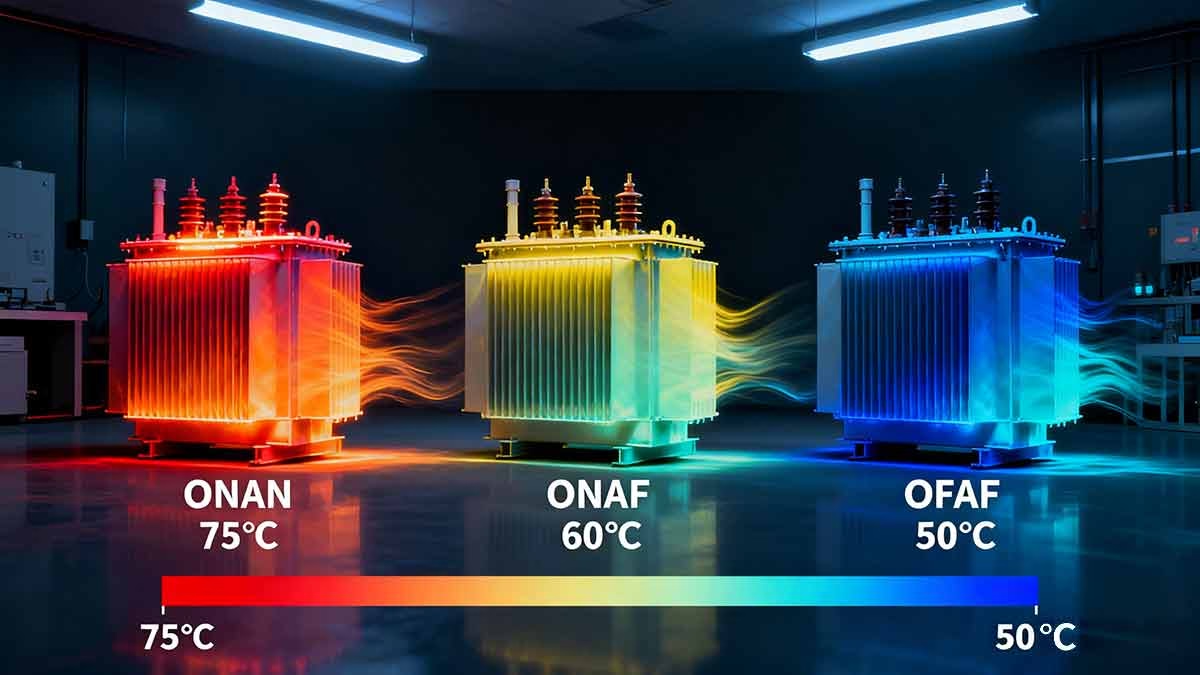
With over two decades in transformer engineering and deployment, I’ve witnessed how the right cooling method can optimize reliability, reduce operational costs, and extend equipment lifespan. In this guide, we’ll demystify these technologies, explore their ideal applications, and dive into the latest innovations shaping the future of oil-immersed transformers.
Contents
hide
ONAN vs ONAF vs OFAF: Key Differences in Cooling Technologies
Struggling to select the right cooling system for your transformer? The choice between ONAN, ONAF, and OFAF isn’t just about load capacity—it impacts everything from installation costs to long-term maintenance. Understanding their core differences is critical to matching your transformer to project needs.
At a glance:
- ONAN: Relies on natural convection for both oil and air circulation—simple, low-cost, and ideal for low-load scenarios.
- ONAF: Combines natural oil flow with forced air (via fans) for enhanced cooling—striking a balance between efficiency and affordability.
- OFAF: Uses pumps to circulate oil and fans to dissipate heat—delivering maximum cooling capacity for high-load, large-scale applications.
Breaking Down Each Cooling Technology
ONAN: The Simplest, Most Reliable Solution
ONAN (Oil Natural Air Natural) is the foundation of oil-immersed transformer design, leveraging basic physics for cooling:
- Operating Principle: Hot oil rises through the transformer core and windings, cools as it circulates through radiators, and sinks back down—no moving parts required.
- Key Advantages: Minimal complexity translates to low initial costs and near-zero maintenance. I recently specified ONAN for a rural substation project, where it operated flawlessly for 15 years with only annual oil testing.
- Limitations: Cooling capacity is limited—unsuitable for high loads or hot ambient temperatures. A client once tried to use ONAN for an expanding manufacturing facility, leading to overheating until we upgraded to ONAF.
ONAF: The Balanced Performer
ONAF (Oil Natural Air Forced) enhances natural oil circulation with forced air cooling:
- Key Features: Oil flows naturally, but fans activate when temperatures rise to accelerate heat dissipation. This adaptability makes it ideal for variable loads.
- Core Benefits: Handles 30–40% more load than ONAN while maintaining moderate costs. For a textile mill with fluctuating power demands, ONAF consistently delivered stable performance without the complexity of OFAF.
- Considerations: Requires minimal power for fans and occasional fan maintenance. It’s the “sweet spot” for most commercial and light industrial projects.
OFAF: Maximum Cooling for High-Demand Applications
OFAF (Oil Forced Air Forced) is the heavyweight of cooling technologies:
- Operation: Pumps circulate oil through the transformer and cooling coils, while fans blast air over the coils—delivering unparalleled heat dissipation.
- Advantages: Suitable for large transformers (50MVA+) and constant high loads. I specified OFAF for a 500MVA power plant project, where it managed extreme heat loads even during summer peak demand.
- Drawbacks: Highest initial cost and maintenance requirements (pumps and fans need regular inspections). Long-term operational costs are offset by its ability to handle loads that would overwhelm other cooling methods.
Cooling Technology Comparison Table
| Characteristic | ONAN | ONAF | OFAF |
|---|---|---|---|
| Cooling Mechanism | Natural Oil + Natural Air | Natural Oil + Forced Air | Forced Oil + Forced Air |
| Complexity | Low (no moving parts) | Medium (fans only) | High (pumps + fans) |
| Initial Cost | Lowest | Medium | Highest |
| Maintenance Requirements | Minimal (annual oil checks) | Moderate (fan lubrication) | High (pump/fan servicing) |
| Cooling Efficiency | Lowest | Medium | Highest |
| Typical Load Capacity | Small (≤10MVA) | Medium (10–50MVA) | Large (≥50MVA) |
| Noise Level | Quiet (≤50dB) | Moderate (60–65dB) | Highest (70–75dB) |
| Power Consumption | None | Low (fans) | High (pumps + fans) |
Real-world context matters: In a desert climate project, we opted for ONAF instead of ONAN—even for a small 8MVA transformer—because extreme ambient temperatures (45°C+) would have compromised ONAN’s performance.
Application-Specific Selection: Matching Transformers to Project Needs
Choosing the right oil-immersed transformer isn’t just about cooling technology—it’s about aligning with your project’s unique demands. From residential developments to power plants, each application requires a tailored approach.
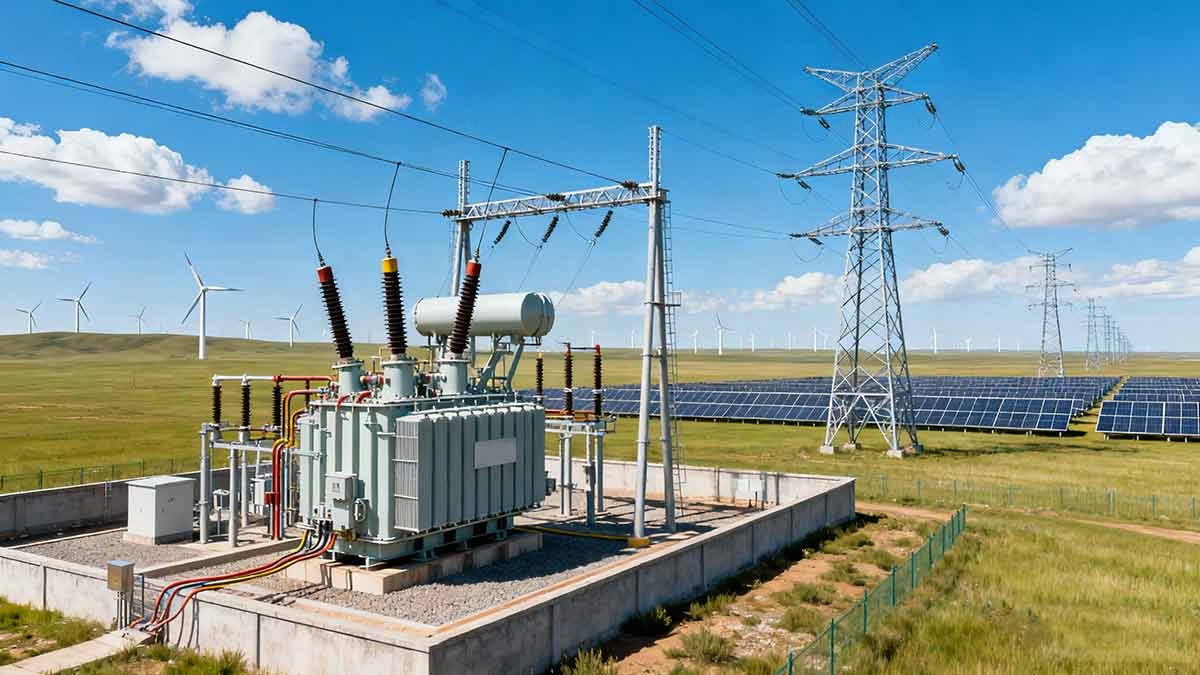
Small-Scale Applications: ONAN’s Domain
ONAN excels in low-load, low-maintenance scenarios:
- Residential & Light Commercial: Powers apartment complexes (50+ units) and small offices. I installed ONAN for a 75-unit residential building, where it efficiently handled lighting, HVAC, and appliance loads.
- Rural Electrification: Ideal for remote villages and small towns, where access to maintenance is limited. A recent rural microgrid project used ONAN transformers to power 300 homes with zero downtime.
- Small Renewable Projects: Works for off-grid solar/wind installations (≤5MVA), where simplicity and reliability are prioritized over maximum capacity.
Medium-Scale Projects: ONAF Shines
ONAF balances efficiency and adaptability for variable or moderate loads:
- Industrial Facilities: Textile mills, food processing plants, and small manufacturing facilities benefit from ONAF’s ability to handle fluctuating loads.
- Commercial Complexes: Shopping malls, office towers, and hotels rely on ONAF to power HVAC, lighting, and tenant equipment. For a 100,000 sq ft shopping center, ONAF accommodated peak holiday loads without overheating.
- Healthcare Facilities: Hospitals and clinics require reliable power with minimal maintenance—ONAF delivers both, ensuring critical equipment stays online.
Large-Scale Installations: OFAF Is Non-Negotiable
OFAF is mandatory for high-power, high-heat applications:
- Power Plants: Handles the massive output of coal, gas, or renewable power plants (100MVA+).
- Heavy Industry: Steel mills, aluminum smelters, and large manufacturing plants with constant high loads. An aluminum smelter project I worked on used OFAF to manage 200MVA of continuous demand.
- Grid Substations: Major distribution hubs (220kV+) rely on OFAF to manage power throughput for entire cities.
Special Considerations for Unique Environments
- Extreme Temperatures: Hot climates (e.g., Middle East) may require ONAF/OFAF even for small loads. A 5MVA project in Dubai used ONAF to combat 50°C ambient temperatures.
- Space Constraints: OFAF delivers higher capacity in a smaller footprint—ideal for cramped urban substations. I designed an OFAF solution for a downtown substation where space was 60% limited compared to standard installations.
- Noise Restrictions: ONAN is preferred in residential or noise-sensitive areas. For a transformer near a school, we chose ONAN despite slightly lower efficiency to meet 55dB noise limits.
Application Selection Guide
| Application Type | Typical Load Range | Recommended Cooling | Key Rationale |
|---|---|---|---|
| Residential/Apartment Complexes | ≤5MVA | ONAN | Low cost, minimal maintenance |
| Small Offices/Retail | 5–10MVA | ONAN/ONAF | Balance of efficiency and affordability |
| Medium Industrial/Commercial | 10–50MVA | ONAF | Handles variable loads, moderate costs |
| Heavy Industry/Power Plants | ≥50MVA | OFAF | Maximum cooling for high demands |
| Rural/Remote Areas | ≤10MVA | ONAN | Reliability, low maintenance |
| Urban Substations (Space-Limited) | 20–50MVA | OFAF | High capacity in compact design |
Performance and Efficiency: How Cooling Methods Impact Operation
Cooling technology directly influences a transformer’s efficiency, load capacity, and operational stability. The right choice ensures your transformer performs optimally across its lifespan—avoiding costly downtime or energy waste.
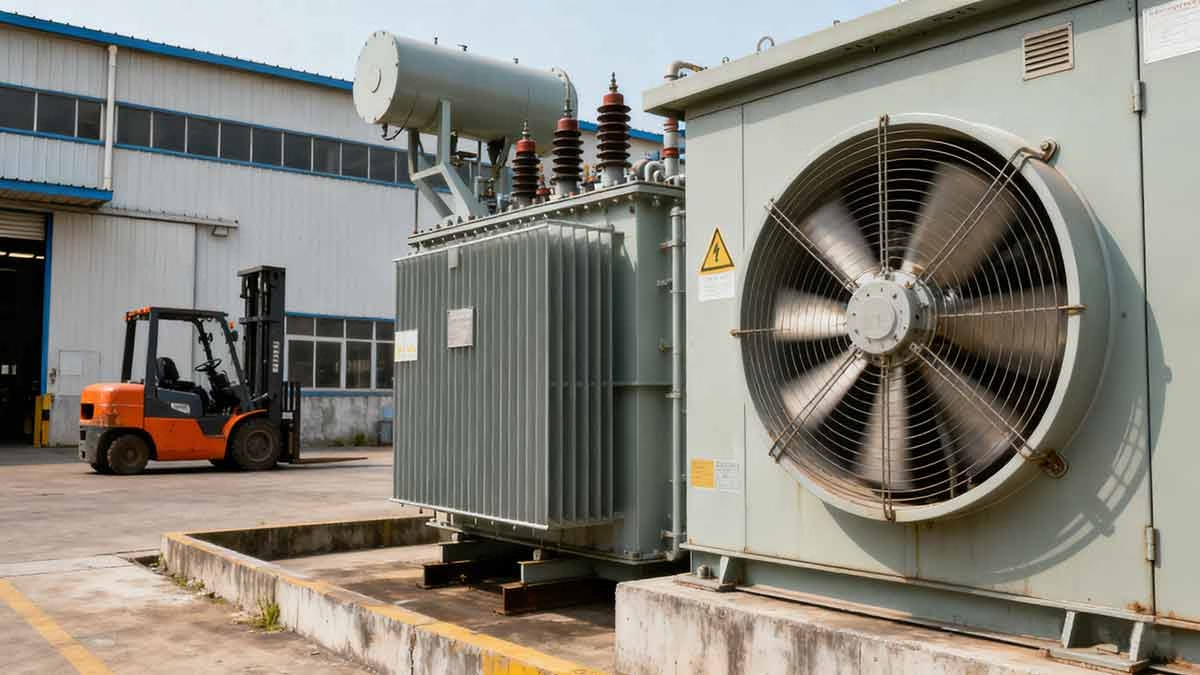
ONAN: Efficiency at Low Loads
- Operational Traits: Excels at 25–75% load, with efficiency peaking at 50% (typically 98.5–99%). At full load, efficiency drops slightly due to slower heat dissipation.
- Real-World Example: A 10MVA ONAN transformer at a small office park operated at 60% load, maintaining 99% efficiency and minimal temperature rise (≤65°C).
- Limitations: Struggles with overloads—even a 10% overload can increase temperature by 15–20%, accelerating insulation degradation.
ONAF: Adaptive Efficiency Across Loads
- Operational Traits: Maintains high efficiency (99–99.3%) across 25–100% load. Fans activate only when needed, optimizing energy use.
- Key Advantage: Handles short-term overloads (20–30% for 2–4 hours) without efficiency loss. A manufacturing client used this to their advantage during peak production periods, avoiding costly upgrades.
- Temperature Control: Smart fan controls (activated at 70°C) keep operating temperatures stable, extending insulation life by 10–15% compared to ONAN.
OFAF: Maximum Efficiency at High Loads
- Operational Traits: Delivers 99.2–99.5% efficiency even at 100% load, thanks to active cooling. Temperature rise is limited to ≤55°C, minimizing wear.
- Critical for High Demand: In a 100MVA power plant transformer, OFAF maintained 99.4% efficiency during 24/7 operation—reducing annual energy losses by 500,000 kWh compared to ONAF.
- Dynamic Response: Quickly adapts to load fluctuations. A steel mill’s 80MVA OFAF transformer handled rapid load changes (from 50% to 100% in 10 minutes) without voltage dips or efficiency drops.
Efficiency Comparison Across Load Ranges
| Load Percentage | ONAN Efficiency | ONAF Efficiency | OFAF Efficiency |
|---|---|---|---|
| 25% | 98.5% | 98.0% | 97.5% |
| 50% | 99.0% | 99.3% | 99.2% |
| 75% | 98.8% | 99.4% | 99.5% |
| 100% | 98.2% | 99.0% | 99.4% |
| 120% Overload | 97.0% (Risky) | 98.5% (Safe) | 99.0% (Safe) |
Environmental factors matter: In hot climates, ONAF’s efficiency surpasses ONAN at all loads. For example, in a 40°C ambient temperature project, ONAF maintained 98.8% efficiency at 100% load, while ONAN dropped to 97.5% and risked overheating.
Maintenance and Longevity: Care Requirements by Transformer Type
A transformer’s lifespan depends largely on maintenance—especially for oil-immersed designs, where oil quality and cooling system performance are critical. Each cooling type has unique care needs, and proactive maintenance can extend operational life by 10–20 years.
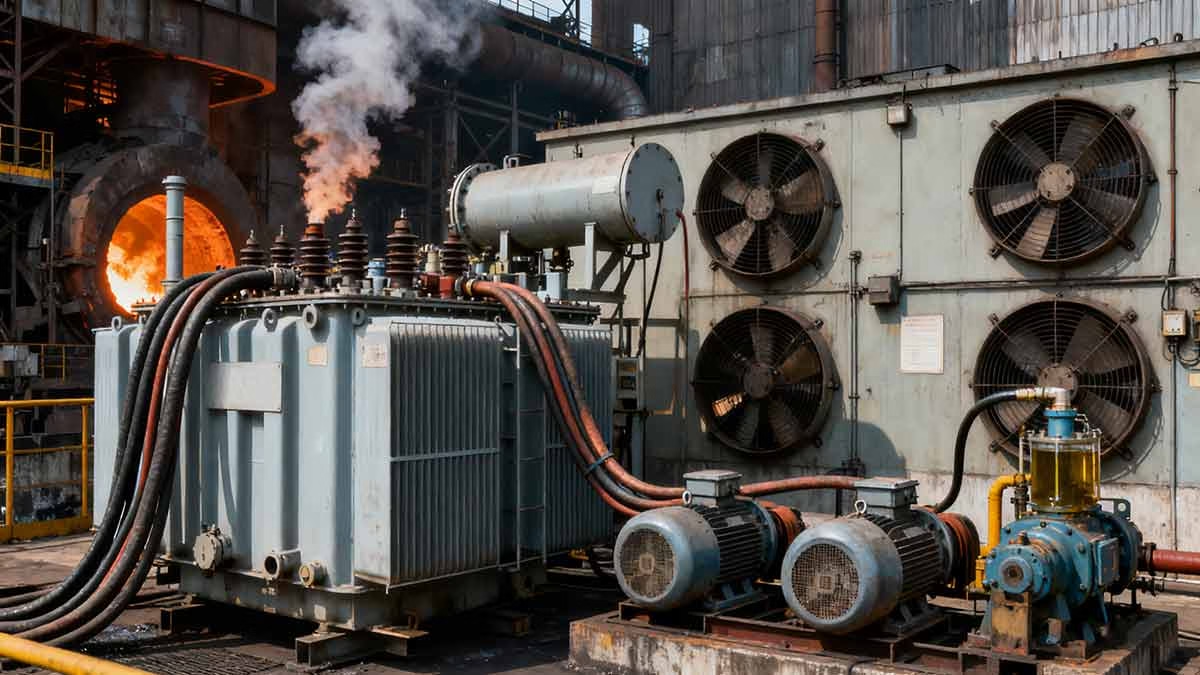
ONAN: Low-Maintenance, Long-Lasting
- Core Maintenance Tasks:
- Annual oil testing (dissolved gas analysis, moisture content, dielectric strength).
- Bi-annual radiator cleaning (remove dust/debris to maintain airflow).
- Annual gasket/seal inspection to prevent leaks.
- Expected Lifespan: 30–40 years with proper care. A rural ONAN transformer I installed in 2000 is still operational, thanks to consistent oil maintenance.
- Common Pitfalls: Neglecting radiator cleaning can reduce cooling efficiency by 20%. I once repaired an ONAN unit that overheated due to clogged radiators—easily avoidable with regular cleaning.
ONAF: Moderate Maintenance Needs
- Core Maintenance Tasks:
- Semi-annual fan inspections (lubricate bearings, check wiring).
- Annual oil testing (same as ONAN).
- Quarterly control system checks (ensure fan activation triggers work correctly).
- Expected Lifespan: 25–35 years. Fan failures are the most common issue—proactive lubrication reduces breakdowns by 80%.
- Pro Tip: Use weather-resistant fans in outdoor installations. For a coastal ONAF project, we specified corrosion-resistant fan motors to withstand salt air.
OFAF: Comprehensive Maintenance Regime
- Core Maintenance Tasks:
- Quarterly pump inspections (check pressure, flow rate, and seals).
- Semi-annual fan servicing (same as ONAF).
- Bi-annual oil filtration (to remove contaminants from forced circulation).
- Annual cooling system performance testing.
- Expected Lifespan: 20–30 years. Pump failures are costly—investing in high-quality pumps reduces maintenance costs by 30%.
- Critical Practice: Use online monitoring to track oil flow and pump performance. A data center OFAF project I worked on used sensors to detect a failing pump early, avoiding a $100,000 outage.
Maintenance and Longevity Comparison
| Factor | ONAN | ONAF | OFAF |
|---|---|---|---|
| Expected Lifespan | 30–40 years | 25–35 years | 20–30 years |
| Maintenance Frequency | Annual | Semi-annual | Quarterly |
| Key Wear Components | Oil, gaskets, radiators | Fans, controls, oil | Pumps, fans, oil filters |
| Critical Maintenance Focus | Oil quality | Fan operation | Pump flow + oil cleanliness |
| Cost of Neglect | Gradual efficiency loss | Reduced cooling capacity | Catastrophic failure |
Proactive maintenance pays off: A utility client reduced their ONAF maintenance costs by 25% by implementing a predictive maintenance program—using vibration sensors to identify fan issues before they failed.
Emerging Technologies in Oil-Immersed Transformers
The oil-immersed transformer industry is evolving rapidly, with innovations focused on efficiency, sustainability, and smart integration. These technologies are redefining performance, reducing environmental impact, and simplifying maintenance.
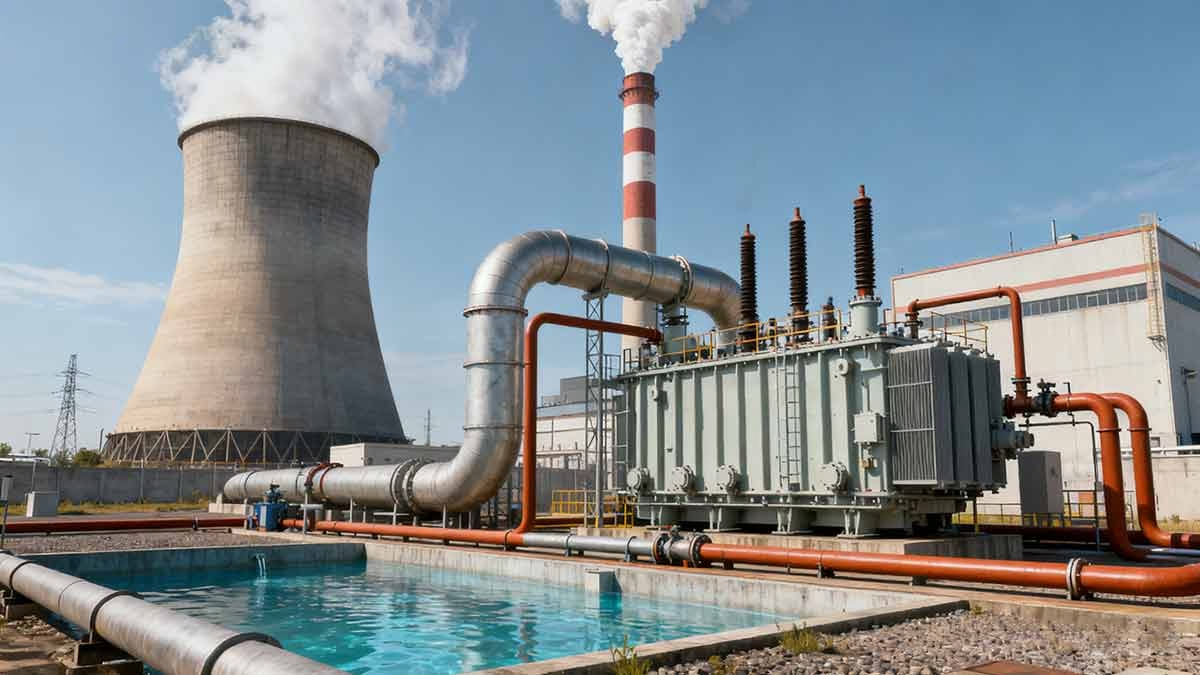
Smart Monitoring & Predictive Maintenance
- IoT-Powered Sensors: Modern transformers include sensors that track oil temperature, dissolved gases, vibration, and load in real-time. Data is transmitted to cloud platforms for remote monitoring.
- AI Analytics: Machine learning algorithms analyze sensor data to predict failures—e.g., detecting abnormal gas levels that indicate insulation breakdown. A utility client used this technology to prevent three major outages in one year.
- Digital Twins: Virtual replicas of transformers simulate performance under different loads and conditions, allowing for optimized cooling and maintenance scheduling. I’m currently implementing a digital twin for a 50MVA OFAF transformer, enabling real-time efficiency adjustments.
Sustainable Cooling Fluids
- Natural Ester Oils: Derived from renewable sources (soybean, rapeseed), these biodegradable oils replace traditional mineral oil. They have a higher fire point (260°C vs. 160°C) and extend transformer life by 15–20% by reducing moisture absorption.
- Synthetic Esters: Offer enhanced thermal stability and fire safety, making them ideal for urban or environmentally sensitive areas. A downtown substation project used synthetic ester-filled ONAF transformers to meet strict fire codes.
- Nanofluids: Advanced fluids infused with nanoparticles (copper, aluminum oxide) boost thermal conductivity by 20–30%. Early trials show nanofluid-filled transformers can reduce cooling system size by 40%.
Hybrid Cooling Systems
- ONAN/ONAF Hybrids: Operate as ONAN under normal loads and switch to ONAF during peaks or hot weather. This reduces energy consumption by 10–15% compared to full-time ONAF.
- Adaptive OFAF Systems: Pumps and fans adjust speed based on real-time load and temperature, optimizing efficiency. A data center project used this technology to cut cooling energy use by 20%.
Solid-State & Superconducting Innovations
- Power Electronic Transformers: Combine traditional magnetic cores with power electronics for precise voltage regulation and harmonic mitigation. Ideal for renewable integration (solar/wind) with variable inputs.
- High-Temperature Superconducting (HTS) Transformers: Use HTS materials to reduce energy losses by 90% compared to conventional designs. While still in pilot stages, HTS transformers promise to revolutionize large-scale power distribution.
Emerging Technology Comparison
| Aspect | Traditional Transformers | Emerging Innovations |
|---|---|---|
| Monitoring | Manual, periodic checks | Real-time IoT sensors |
| Maintenance | Scheduled | Predictive AI-driven |
| Cooling Fluid | Mineral oil | Natural/synthetic esters |
| Cooling Efficiency | Fixed by design | Adaptive/hybrid systems |
| Environmental Impact | Moderate (mineral oil risk) | Low (biodegradable fluids) |
| Smart Grid Integration | Limited | Full two-way communication |
These innovations aren’t just futuristic—they’re already delivering value. A renewable energy project I worked on used natural ester-filled transformers with IoT monitoring, reducing operational costs by 25% and cutting carbon emissions by 30%.
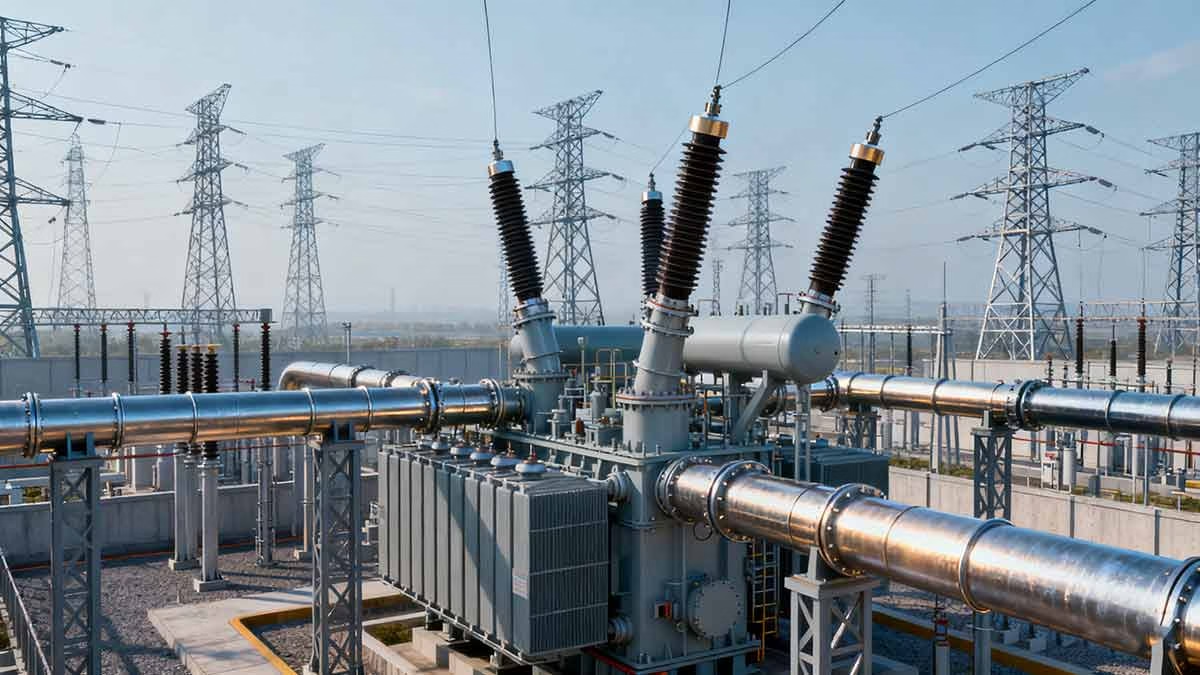
Conclusion
Selecting the right oil-immersed transformer requires balancing cooling technology, application needs, efficiency, and maintenance. ONAN offers simplicity for low-load scenarios, ONAF delivers versatility for medium-scale projects, and OFAF provides maximum cooling for high-demand installations.
As the industry evolves, emerging technologies—from IoT monitoring to sustainable fluids—are making transformers more efficient, reliable, and environmentally friendly. By understanding both traditional and cutting-edge solutions, you can choose a transformer that meets current demands while future-proofing your infrastructure.
Whether you’re designing a rural microgrid or a large industrial facility, the key is to align cooling technology with your project’s unique load profile, environmental conditions, and long-term goals. With proper selection and maintenance, an oil-immersed transformer will deliver decades of reliable service.
